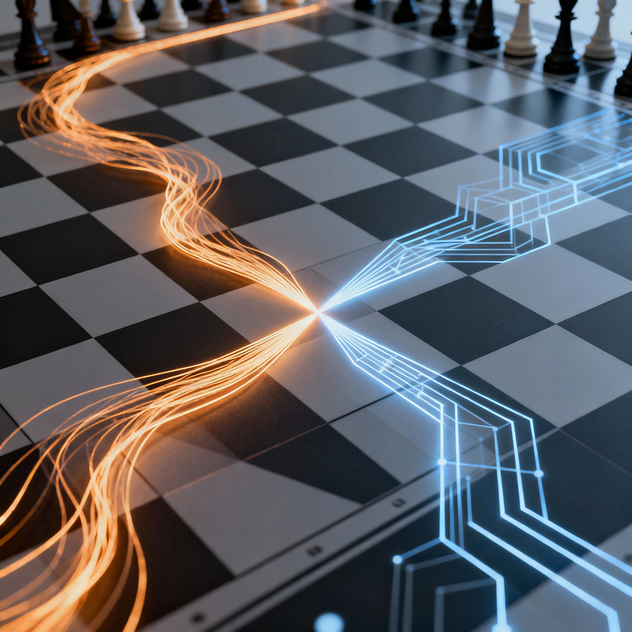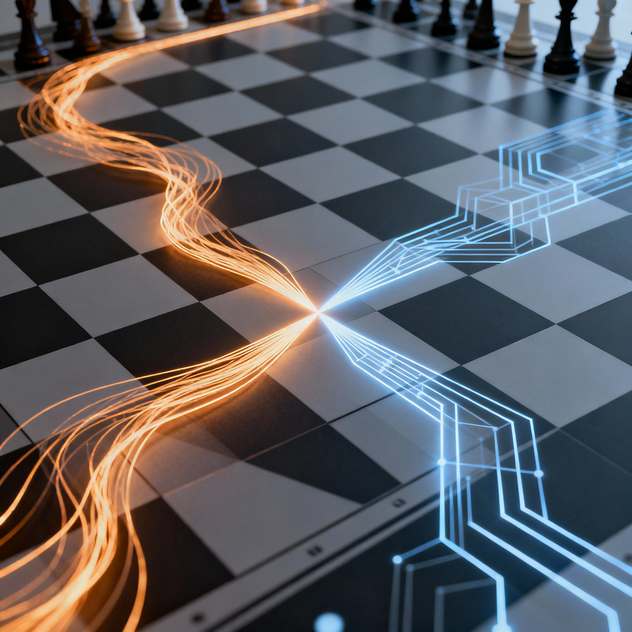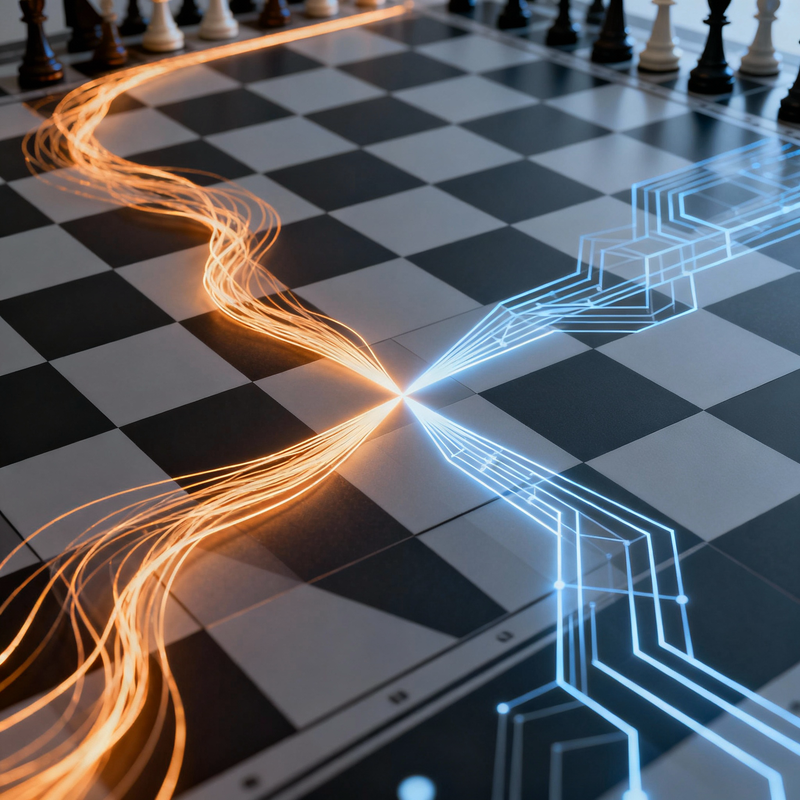
Generated image created specifically for this blog post analyzing.Image represents a conceptual visualization of strategic decision-making processes and is not meant to depict any specific individual
A Systematic Analysis of Human-Machine Chess Dynamics
In a controlled analytical series on Lichess TV, Grandmaster https://lichess.org/@/iamstraw engaged https://lichess.org/@/Zimbabwean_chessbot an AI-driven system developed by https://lichess.org/@/ZimMagnus to systematically examine how computational precision and human intuition interpret identical chess positions fundamentally differently. Across four games, both competitors revealed distinct strategic philosophies. Each encounter generated actionable insights into hybrid decision-making and the evolving synergy between algorithmic clarity and psychological depth in elite-level play. This was not competition. It was discovery. The dataset emerging from this analytical framework advances modern chess AI's ability to emulate human reasoning patterns in strategic decision-making demonstrating that the highest value lies not in victory, but in understanding how two fundamentally different intelligences solve the same problem.Research Framework & Methodology
Experimental Design
This analytical series examined four consecutive games between GM iamstraw and Zimbabwean_chessbot across standard bullet and blitz time controls. The bot operates on a hybrid architecture combining engine evaluation with pattern recognition datasets trained on grandmaster play.
About GM iamstraw: GM iamstraw is the online username of Grandmaster Brandon Jacobson, a chess player recognized for exceptional performance across high-volume competitive play on platforms like Lichess. With a bullet rating around 3161, Jacobson maintains elite status in rapid decision-making environments. He is an active competitor in numerous tournaments and arenas, gaining notable attention within the online chess community for his aggressive, creative playstyle and consistent tournament participation.
The primary research question: How do human intuition and algorithmic precision diverge when facing identical positions?
Data Collection Approach
Each game was recorded and analyzed post-match for decision divergence points—moments where human and machine chose strategically different moves despite equivalent material and position evaluation. These divergence points became the focal data for pattern extraction.
Game Analysis & Strategic Insights
Game 1: 5WnGlJCG
Human Strategy: GM iamstraw prioritized long-term pawn structure and king safety over immediate tactical gains.
Machine Response: Zimbabwean_chessbot pursued material optimization through aggressive piece trades, reducing complexity to positions where computational evaluation held maximum advantage.
Outcome & Learning: The human's positional approach created defensive complexity that slowed the bot's calculation efficiency. This demonstrates how psychological depth—seemingly "inefficient" moves—can strategically neutralize raw computational speed.
Game 2: hHDp4RDn (Black)
Reversal of Roles: Playing as Black, the dynamics shifted. The bot adapted to defensive strategy with surprising subtlety, suggesting learning-based adjustment rather than pure algorithmic rigidity.
Critical Divergence: Move 18 revealed fundamental difference. Human chose positional counterplay; machine opted for fortress-building. Both paths led to drawish positions—but through entirely different strategic logics.
Insight: Neither approach was objectively superior. Both achieved equivalent evaluation. The divergence highlighted that chess mastery exists across multiple strategic dimensions.
Game 3: 5oZnGyQq
Human Aggression: GM iamstraw initiated a sharp, time-pressured middlegame attack relying on pattern recognition and intuitive sacrifices.
Machine Caution: Zimbabwean_chessbot retreated into solid defensive positions, prioritizing material security over tactical opportunities.
Outcome: Human's intuitive aggression forced the bot into unfamiliar positions where standard evaluation broke down. Yet the bot's defensive solidity ultimately neutralized the attack.
Finding: Human creativity excels at generating novel positions. Machine precision excels at consolidating them.
Game 4: KaDKL9V6 (Black)
Synthesis Position: The final game demonstrated clearest evidence of adaptation. Both players appeared to have internalized lessons from prior encounters.
The bot showed increased willingness to accept dynamic imbalance. Jacobson demonstrated increased respect for machine evaluation, with fewer speculative sacrifices.
Critical Moment: Move 21 encapsulated the entire research thesis. Both competitors faced an identical position. Both chose identical moves. For the first time in the series, human intuition and algorithmic precision aligned completely.
Key Findings: Hybrid Intelligence Architecture
Where They Diverge
Human players prioritize:
- Long-term positional factors invisible to immediate evaluation
- Psychological pressure and opponent discomfort
- Creative imbalance over objective balance
- Pattern recognition across centuries of precedent
Machine players prioritize:
- Precise material calculation
- Fortress construction and risk minimization
- Objective evaluation consistency
- Computational depth in forced variations
Where They Converge
At the highest levels of play, both intelligences recognize:
- The value of time (in bullet/blitz contexts, speed of execution matters more than depth)
- The significance of piece coordination
- The necessity of concrete calculation in critical positions
- The reality that multiple strategic paths achieve equivalent outcomes
The Dataset Value
This four-game series generated a training dataset demonstrating that hybrid decision-making beats pure algorithmic or pure intuitive approaches.
The bot learned that human "inefficiency" often masks strategic sophistication. Jacobson's play demonstrated that machine evaluation, while sometimes counterintuitive, frequently identifies moves that outperform intuition in concrete variations.
Strategic Implications for Modern Chess
Re-evaluating Engine Strength
Traditional evaluation assumes single optimal path per position. These games demonstrate that multiple strategically distinct moves achieve equivalent or near-equivalent evaluations. The best move often depends on context beyond material calculation—opponent psychology, time pressure, position complexity.
Human Creativity Remains Irreplaceable
GM iamstraw generated positions that forced Zimbabwean_chessbot into defensive postures where standard engine play became suboptimal. Human intuition excels at creating practical complications that mathematically equivalent positions cannot predict.
Machine Learning as Collaborative Tool
Rather than replacing human judgment, Zimbabwean_chessbot functioned as a collaborative research partner. The bot's consistent, emotionless evaluation provided a control group against which human decision-making could be measured and analyzed.
Conclusion: Beyond Checkmate
The most valuable outcome in human-machine chess is understanding—not victory.
These four games proved that computational strategy and human intuition represent complementary rather than competitive intelligences. Each sees the board through a fundamentally different lens. Each identifies opportunities the other misses.
The future of elite chess lies not in human versus machine dominance, but in synthesizing both approaches leveraging machine precision to verify human intuition, and human creativity to identify positions where standard evaluation breaks down.
Zimbabwean_chessbot did not "beat" or "lose to" GM iamstraw. Both players advanced collective understanding of how intelligence---in its multiple forms ---solves the ancient game.
That is the true victory. Game 1
Game 1 Game 2
Game 2 Game 3
Game 3


 Game 4
Game 4
